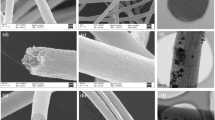Abstract
High molecular weight partial hydrolysis polyacrylamide (HPAM) is widely used in the oil recovery, and however, these high molecular weight HPAM will experience a rapid degradation when Fe2+ was existed in the system. Some studies have implied it was a radical assisted decomposition process. However, no direct evidence had been provided in the reported works. Here, we investigated the effect of different metal ions, and the addition of (2,2,6,6-tetramethylpiperidinooxy) TEMPO to know the polymer degradations of the system. Further, by conducting electron paramagnetic resonance (EPR) on the Fe2+/HPAM system, we firstly provide a solid proof of the radical assist degradation process for the HPAM in the presence of Fe2+ and oxygen. The mechanism has also been provided based on the observations.
Graphical abstract
The degradation mechanism is first revealed by EPR measurements for a Fe2+ containing HPAM solution. A solid proof of the radical assists degradation process for the HPAM in the presence of Fe2+ and oxygen.









Similar content being viewed by others
References
Li XE, Xu Z, Yin H, Feng Y, Quan H (2017) Comparative studies on enhanced oil recovery: thermoviscosifying polymer versus polyacrylamide. Energy Fuels 31(3):2479–2487
Hadi NJ, Al-Maamori MH, Mohmmed SH (2019) PAM aqueous solution flow and enhance oil recovery. Biosci Biotechnol Res Commun 12(5):131–139
Que T, Lou Q, Maierdang T (2014) A review of molecular weight distribution characterization and testing method of pam for oil recovery. Polym Bull 6:95–100
Song W, Zhang Y, Hamidian AH, Yang M (2020) Biodegradation of low molecular weight polyacrylamide under aerobic and anaerobic conditions: effect of the molecular weight. Water Sci Technol 81(2):301–308
Ding M, Han Y, Liu Y, Wang Y, Zhao P, Yuan Y (2019) Oil recovery performance of a modified HAPAM with lower hydrophobicity, higher molecular weight: a comparative study with conventional HAPAM, HPAM. J Ind Eng Chem 72:298–309
Jinqiang HU, Renqiang LIU, Yujie W, Lina SUN, Xianglong Z (2006) Mobility control effect on oil recovery efficiency in alkaline water flooding. J Daqing Pet Inst 30(4):19–21
Abdullahi MB, Rajaei K, Junin R, Bayat AE (2019) Appraising the impact of metal-oxide nanoparticles on rheological properties of HPAM in different electrolyte solutions for enhanced oil recovery. J Petrol Sci Eng 172:1057–1068
Liu T, You H, Chen Q (2009) Heterogeneous photo-Fenton degradation of polyacrylamide in aqueous solution over Fe(III)-SiO2 catalyst. J Hazard Mater 162(2–3):860–865
Shupe RD (1981) Chemical-stability of polyacrylamide polymers. J Petrol Technol 33(8):1513–1529
Caulfield MJ, Qiao GG, Solomon DH (2002) Some aspects of the properties and degradation of polyacrylamides. Chem Rev 102(9):3067–3083
Liu Z, Zhu H, Chen B, Yi F (2013) Study of the effect of Fe~(2+) on rheological behavior of HPAM. Oil Drill Prod Technol 35(3):86–89
Liu FB, Karoui H, Rockenbauer A, Liu SM, Ouari O, Bardelang D (2020) EPR spectroscopy: a powerful tool to analyze supramolecular host center dot guest complexes of stable radicals with cucurbiturils. Molecules 25(4):776
Martin RE, Pannier M, Diederich F, Gramlich V, Hubrich M, Spiess HW (1998) Determination of end-to-end distances in a series of TEMPO diradicals of up to 2.8 nm length with a new four-pulse double electron electron resonance experiment. Angewandte Chemie-Int Edit 37(20):2834–2837
Acknowledgements
We thank the National Science and Technology Major Project (Grants 257026), Cai Y and Wang Z contributed equally to this work.
Author information
Authors and Affiliations
Corresponding author
Additional information
Publisher's Note
Springer Nature remains neutral with regard to jurisdictional claims in published maps and institutional affiliations.
Rights and permissions
About this article
Cite this article
Cai, Y., Wang, Z., Zhang, J. et al. Free radical induced degradation of high molecular weight partial hydrolysis polyacrylamide (HPAM) in a ferrous iron containing system. Polym. Bull. 79, 9397–9406 (2022). https://doi.org/10.1007/s00289-021-03949-7
Received:
Revised:
Accepted:
Published:
Issue Date:
DOI: https://doi.org/10.1007/s00289-021-03949-7




